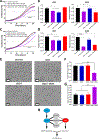ELF4 Is a Target of miR-124 and Promotes Neuroblastoma Proliferation and Undifferentiated State
- PMID: 31624087
- PMCID: PMC6942226
- DOI: 10.1158/1541-7786.MCR-19-0187
ELF4 Is a Target of miR-124 and Promotes Neuroblastoma Proliferation and Undifferentiated State
Abstract
13-Cis-retinoic acid (RA) is typically used in postremission maintenance therapy in patients with neuroblastoma. However, side effects and recurrence are often observed. We investigated the use of miRNAs as a strategy to replace RA as promoters of differentiation. miR-124 was identified as the top candidate in a functional screen. Genomic target analysis indicated that repression of a network of transcription factors (TF) could be mediating most of miR-124's effect in driving differentiation. To advance miR-124 mimic use in therapy and better define its mechanism of action, a high-throughput siRNA morphologic screen focusing on its TF targets was conducted and ELF4 was identified as a leading candidate for miR-124 repression. By altering its expression levels, we showed that ELF4 maintains neuroblastoma in an undifferentiated state and promotes proliferation. Moreover, ELF4 transgenic expression was able to counteract the neurogenic effect of miR-124 in neuroblastoma cells. With RNA sequencing, we established the main role of ELF4 to be regulation of cell-cycle progression, specifically through the DREAM complex. Interestingly, several cell-cycle genes activated by ELF4 are repressed by miR-124, suggesting that they might form a TF-miRNA regulatory loop. Finally, we showed that high ELF4 expression is often observed in neuroblastomas and is associated with poor survival. IMPLICATIONS: miR-124 induces neuroblastoma differentiation partially through the downregulation of TF ELF4, which drives neuroblastoma proliferation and its undifferentiated phenotype.
©2019 American Association for Cancer Research.
Conflict of interest statement
Conflict of Interest: The authors declare no potential conflicts of interest.
Figures







References
-
- Park JR, Eggert A, Caron H. Neuroblastoma: biology, prognosis, and treatment. Elsevier. 2008; - PubMed
-
- Brodeur GM. Neuroblastoma: biological insights into a clinical enigma. Nat Rev Cancer. 2003;3:203–216. - PubMed
-
- Matthay KK, Villablanca JG, Seeger RC. Treatment of High-Risk Neuroblastoma with Intensive Chemotherapy, Radiotherapy, Autologous Bone Marrow Transplantation, and 13-cis-Retinoic Acid. Mass Medical Soc. 1999; - PubMed
Publication types
MeSH terms
Substances
Grants and funding
LinkOut - more resources
Full Text Sources
Medical
Molecular Biology Databases
Research Materials
Miscellaneous

